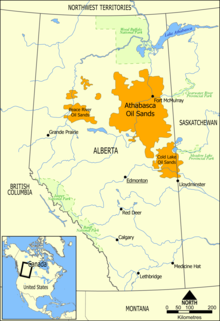
Back نفط أثاباسكا الرملي Arabic Athabaské ropné písky Czech Athabasca-Ölsande German Arenas de alquitrán de Athabasca Spanish Athabascan öljyhiekka Finnish Sables bitumineux de l'Athabasca French Areas betuminosas do Athabasca Galician חולות הזפת של אלברטה HE Athabasca tjæresand NB Areias betuminosas do Athabasca Portuguese
| Athabasca oil sands | |
|---|---|
 | |
| Country | Canada |
| Region | Northern Alberta |
| Offshore/onshore | Onshore, mining |
| Coordinates | 57°01′N 111°39′W / 57.02°N 111.65°W |
| Operators | Syncrude, Suncor Energy, Canadian Natural Resources, Total S.A., Imperial Oil, Petro Canada, Devon Energy, Husky Energy, Statoil, Nexen |
| Partners | Chevron Corporation, Marathon Oil, ConocoPhillips, BP, Occidental Petroleum |
| Field history | |
| Discovery | 1848 |
| Start of production | 1967 |
| Production | |
| Current production of oil | 2,800,000 barrels per day (~1.4×108 t/a)[1] |
| Estimated oil in place | 133,000 million barrels (~1.81×1010 t)[2] |
| Producing formations | McMurray, Clearwater, Grand Rapids |
The Athabasca oil sands, also known as the Athabasca tar sands, are large deposits of bitumen, a heavy and viscous form of petroleum, located in northeastern Alberta, Canada. These reserves are one of the largest sources of unconventional oil in the world, making Canada a significant player in the global energy market.[3]
As of 2023 Canada's oil sands industry, along with Western Canada and offshore petroleum facilities near Newfoundland and Labrador, continued to increase production and were projected to increase by an estimated 10% in 2024 representing a potential record high at the end of the year of approximately 5.3 million barrels per day (bpd).[4] The surge in production is attributed mainly to growth in Alberta's oilsands.[4] The expansion of the Trans Mountain pipeline—the only oil pipeline to the West Coast—will further facilitate this increase, with its capacity set to increase significantly, to 890,000 barrels per day from 300,000 bpd currently.[5][4] Despite this growth, there are warnings that it might be short-lived, with production potentially plateauing after 2024.[4] Canada's anticipated increase in oil output exceeds that of other major producers like the United States, and the country is poised to become a significant driver of global crude oil production growth in 2024.[4] The exploitation of these resources has stirred debates regarding economic development, energy security, and environmental impacts, particularly emissions from the oilsands, prompting discussions around emissions regulations for the oil and gas sector.[4][6][7][8][9][10][11]
The Athabaska oil sands, along with the nearby Peace River and Cold Lake deposits oil sand deposits lie under 141,000 square kilometres (54,000 sq mi) of boreal forest and muskeg (peat bogs) according to Government of Alberta's Ministry of Energy,[12] Alberta Energy Regulator (AER) and the Canadian Association of Petroleum Producers (CAPP).
- ^ IHS CERA (May 18, 2009). "Oil Sands Move from the 'Fringe to Center' of Energy Supply". RigZone. Archived from the original on 21 May 2009. Retrieved 2009-05-19.
- ^ Cite error: The named reference
reservewas invoked but never defined (see the help page). - ^ Turgeon, Andrew; Morse, Elizabeth (19 October 2023). "Petroleum". National Geographic. Education. National Geographic Society. Retrieved 6 February 2024.
- ^ a b c d e f Bakx, Kyle (12 October 2023). "Canada could lead the world in oil production growth in 2024". CBC News. Retrieved 6 February 2024.
- ^ "Trans Mountain mulling how to remove 'obstruction' causing newest construction delay". Canadian Press. 1 February 2024. Retrieved 6 February 2024 – via CBC News.
- ^ "Ecocide must be listed alongside genocide as an international crime". The Guardian. 2021-06-22. ISSN 0261-3077. Retrieved 2023-06-21.
- ^ "Tar sands: tearing the flesh from the Earth". theecologist.org. 18 August 2009. Retrieved 2023-06-21.
- ^ "Indigenous groups say Big Oil's pollution threatens their existence in Canadian forest". NBC News. 2021-11-22. Retrieved 2023-06-21.
- ^ "Trudeau Is Betting $9 Billion on a Plan to Clean Up the World's Dirtiest Oil". Bloomberg.com. 2023-06-05. Retrieved 2023-06-21.
- ^ Weisbrod, Katelyn (2021-11-21). "Canada's Tar Sands: Destruction So Vast and Deep It Challenges the Existence of Land and People". Inside Climate News. Retrieved 2023-06-21.
- ^ "The terrible toll of tar sands mining on Canada's Native people". Mother Jones. Retrieved 2023-06-21.
- ^ "Alberta's Oil Sands 2006" (PDF). Government of Alberta. 2007. Archived from the original (PDF) on 2008-02-27. Retrieved 2008-02-17.
© MMXXIII Rich X Search. We shall prevail. All rights reserved. Rich X Search